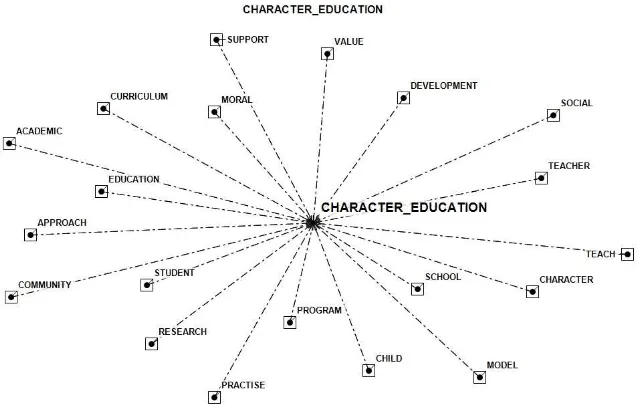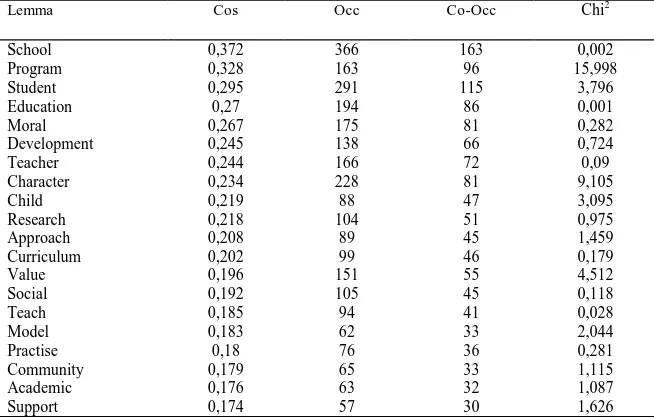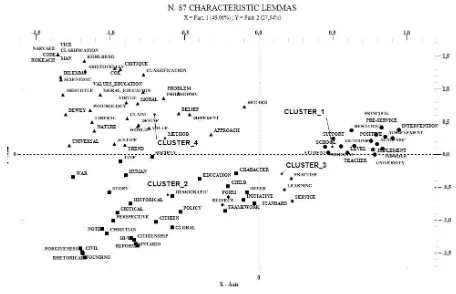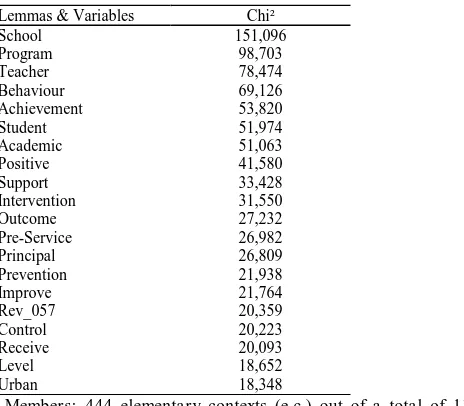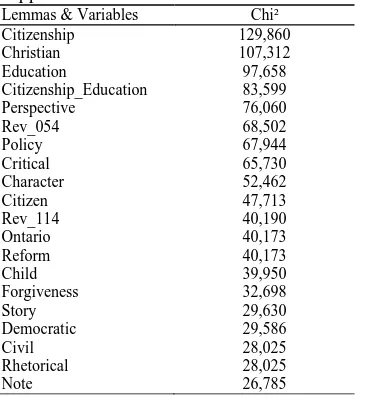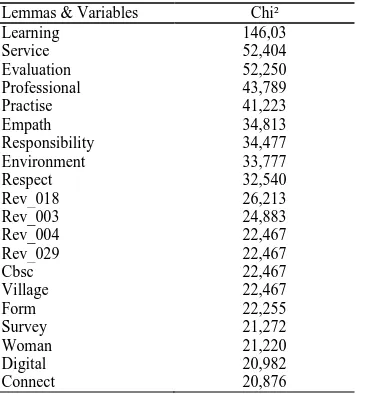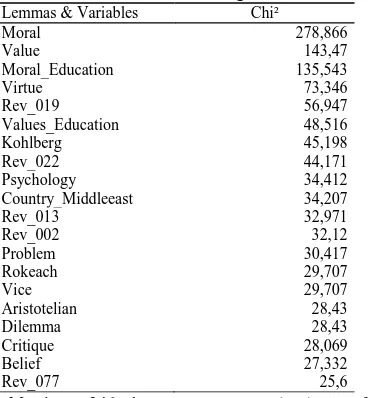Literature Review
Chiara Pattaro
*Author information
*
Department of Political Science, Law and International Studies, University of Padova, Italy.
Contact author’s email address
*
chiara.pattaro@unipd.it
Article first published online
February 2016
HOW TO CITE
Pattaro, C. (2016). Character Education: Themes and Researches. An academic Literature Review.
Character
Education:
Themes
and
Researches.
An
academic
Literature
Review
Chiara Pattaro*
______________________________________
Abstract: Character education is both a rooted and developing discipline. Even though there is no consensual definition, it can be widely described as a school-based process to promote personal development in youth, through the development of virtue, moral values, and moral agency.Starting from the growing interest about this theme in recent years, this article aims at using the “character education” analysis category to conduct an exploratory research on the main tendencies in the international literature, defining which are the main topics, exploring the way these topics develop in terms of theory and empirical research and analyzing how they relate to each other. In view of this goal, titles and abstracts of 261 articles published in 145 peer-reviewed academic journals over the period 2005-2014 were selected from Education Source, ERIC, Psychology & Behavioral Sciences Collection and SocINDEX databases. Articles’ titles and abstract were analyzed through the T-Lab software, using different content analysis techniques. Although many ambivalences and ambiguities affect the meaning attributed to the character education, some key trends emerge from this literature review and the considered studies seem to agree that character education can play an important role in the construction of children and adolescents’ identity and can be a distinctive intervention for youth education and socialization.
Keywords: character education, socialization, education, citizenship education
______________________________________
*
Introduction: defining the domain of character education
Character education is both an old and new, in a sense a rooted and developing, discipline (Berkowitz & Bier, 2007; 2014; Berkowitz & Hoppe, 2009).
It is as old as the concern for the socialization of young people.
Indeed, all societies have always wondered (particularly through philosophy, developmental psychology, pedagogy and sociology of education) on the ways to invest in the socialization of the younger generation in order to ensure social progress and their own survival. The concern to provide a sort of ethical compass for young people is shared - even though in different ways and with different forms - from all formal and informal actors, that deal, for various reasons, with the socialization processes (firstly, family and formal educational institutions such as school) (Maccarini, 2003; Besozzi, 2006; Lapsley & Navarez, 2006; Berkowitz & Bier, 2007; 2014).
However, it is mainly in the past two centuries that a real emphasis on positive socialization of youth has widely spread (deMause, 1974). In particular, with reforms such as mandatory education, the recognition of children’s rights, and the growth of the scientific studies on the childhood’s themes, this attention has been further promoted in the last half century, with an especial development in recent decades (Berkowitz & Bier, 2007).
In the current transition, education tends to become “personalizing education”. That is, it deepens its educational intentionality, representing a
“constructive” education of personality traits considered important. A strong interest in the “non-cognitive” - covering dimensions such as citizenship, sociability, emotions, creativity, and more - appears. Also the idea of flourishing emerges, meaning the ability of people to be resilient to the social and personal dynamics, developing long-term life plans and maintaining lasting commitments to ideal and not individualist concerns. It involves the ability to articulate a particular sense of well-being, development and self-fulfillment, that goes beyond the alternatives of utilitarian and expressive thought (Maccarini, 2014).
educational social actors. In this “new” background, therefore the social sciences show increasing attention to character (and citizenship) education.
Of course, this focus is expressed in very different meanings and aspects, sometimes still to be explored - from the critical strands to the attempts of a new institutionalization - so that the character education category can be described as “part of a semantic minefield” (Berkowitz & Bier, 2007, p. 30).
Terminology indeed gets complicated by historical changes, political affiliations and public connotations (Berkowitz & Bier, 2007), and the issues surrounding character education are riven by rivalries so much that the terms of reference seem sometimes to work like code words, that betray certain ideological and political commitments (Lapsley & Navarez, 2006).
Nevertheless, a literature trying to fill the conceptual and ideological gap, or at least to deal with it in a direct way, has emerged in recent years (Lapsley & Narvaez, 2006).
As character education (as, more broadly, education) refers to a comprehensive field of study, this literature consists of both theoretical and research-based works that offer an interdisciplinary perspective, drawing from the disciplines of education, psychology, pedagogy, philosophy and sociology.
Mapping the character education field study
Starting from the views discussed in the introduction about the new and growing interest in the field of character education - characterized however by a large presence of several approaches and definitions - the aim of this article is to use the “character education” analysis category to conduct an exploratory research on the main tendencies in the international literature.
What are the main topics within this scientific domain? How do these topics relate to each other?
How has this scientific domain developed in terms of theory and empirical research?
What are the different perspectives and research methods?
choosing the databases Education Source, ERIC, Psychology & Behavioral Sciences Collection and SocINDEX1.
The articles in which the keyword “character education” recurred in the title or abstract, published in academic peer reviewed journals and in English language, were taken into consideration.
In total, 261 articles published in 145 peer-reviewed academic journals were selected.
These references are mainly American, but there is a growing development (even if more limited compared to the American one) in Europe, Canada, Asia and Middle East. Although character education under various names has existed for centuries in the U.S, Europe and elsewhere, it has had indeed a renaissance and has become increasingly popular in current educational policies and practices in many countries since 90’s - particularly in the United States, where the study tradition is recognized as an inescapable point of reference in this field.
Titles and abstracts of selected articles were analyzed through the T-Lab software2, using a content analysis3methodology consisting of techniques that quantitatively classify the qualitative information contained in spoken or written materials (Krippendorff, 2004). This is a sort of compromise between statistical synthesis, hermeneutics of the text,
1
Coverage in Education Source spans all levels of education from early childhood to higher education.
ERIC is considered to be the primary database for education literature; it provides access to information from journals included in the Current Index of Journals in Education and Re-sources in Education Index.
Psychology & Behavioral Sciences Collection provides extensive coverage for a broad range of subjects in the fields of psychology.
SocINDEX offers comprehensive coverage of sociology, encompassing all sub-disciplines and closely related areas of study.
2
researcher’s sensitivity and deepening of the context, in order to achieve an optimal use of the available information (Nigris, 2003; Tuzzi, 2003) 4.
Coherently with the described methodological approach, at first, a word associations analysis was performed, in order to interpret the keyword
“character education” in the semantic context in which it was produced. This TLab tool measures the intensity of the association between co-occurring (i.e. simultaneously present in the same sentence or paragraph) pairs of words (lexical units). The selection of associated words is bottom-up clustering which highlights emerging themes, providing a representation of the corpus’ contents through a few significant thematic clusters. Clusters consist of a set of elementary contexts (i.e. sentences or paragraphs) characterized by the same patterns of keywords and correspond therefore to relatively homogeneous topics.
As this analysis is limited to the studies published in English in peer-reviewed academic journals present in the selected databases, it does not consist in a comprehensive representation of the whole field of study. Therefore, we think that this exploratory research may provide useful information about the key trends and the more relevant research questions from various points of view.
4
The imported texts consisted of 261 titles and abstracts (corpus), with a size of 39208 words (word tokens). The corpus is therefore a medium sized one (Tuzzi, 2003). There were 5182 word types, and 2404 hapax (words occurring only once). The ratio of word types/word tokens is 13.2%, and the ratio of hapax/word types is 46,3%. The used language is therefore rather specific, but within a corpus that can be considered analyzable by a statis-tical approach (for the methodological criteria, see Tuzzi, 2003; Bolasco, 2004).
For each text (corresponding to a single title and abstract) were associated classification var-iables: year of publication, journal where it was published, Author's Affiliation Country. The analysis was performed on 780 selected words, with a minimum threshold of 5 occur-rences indicated by T-Lab.
5
Character education is…
As stated above, firstly, a word association analysis was carried out, to assess how co-occurrence relationships determine the local meaning of the target word “character education” (the keywords most associated with character education are displayed in Fig. 1 and Tab. 1).
In order to understand the word association analysis, we have to keep in mind that the more two words co-occur, the closer they are in the dimensional space.
In addition, T-lab enables to recover all the elementary contexts (paragraphs or sentences) in which the two associated items are present, allowing to analyze the words in their frame of reference.
The semantic field organized around “character education” shows some particularly relevant themes.
Figure 1. “Character education” and its association
Associations with school, student, child, education, approach and model
An overview emerges in which different approaches provide different interpretations on such definitions, particularly in the used language and in the borders of what they enclose and exclude. However, the central focuses of these definitions, overlap considerably among the related approaches (e.g., character, moral, citizenship and civic education, social emotional learning, etc.) (Berkowitz & Hoppe, 2009). Such approaches share the idea of an inextricable union of person and context, which is expressed by the reciprocal interaction among the dispositions, interests, and potentialities of the person and the changing contexts of learning, development, and socialization (Lapsley & Narvaez, 2006). Even though there is no consensual definition of character education and - given the broad net that character education casts - no definition is able to satisfy all concerned parties (Berkowitz, 1997), however, it is possible to define roughly some distinctive characteristics, containing the field of study. Character education therefore can be widely defined, according to Berkowitz & Hoope (2009, p. 132) “the deliberate attempt to promote the development of virtue, moral values, and moral agency in youth” within educational settings, especially in schools (Berkowitz & Hope, 2009, p. 132).
The association with character refers to further attention, widely present in the articles; this association, more than others, also highlights the ambiguity and the slippery slope of character education. Indeed, defining character is not a straightforward matter. In a broad sense, habits, traits, and virtues are three interdependent and mutually implicative concepts that are foundational to most traditional accounts of moral character (Lapsley & Narvaez, 2006).
However, more often the international literature does not focus on the character definition, but rather on the fact that, although character elements are similar, character education applications and individual attitudes and behaviors are influenced by the different socio-cultural contexts and economic and religious beliefs, which effect character education curricula regarding societal behaviors (see e.g. Lee, 2013; Ugurlu, 2014). In this sense, different approaches emerge, ranging from the idea of character education as a tool to develop the personal potentiality, in view of a positive development linked to greater wellbeing (see e.g. Holtzapple, 2011; Lee, 2013 ), to a meaning of character education as an instrument to preventing negative behaviors (see e.g. Battistich, 2008) or, even, to preserve the cultural heritage and the moral values of a society (see e.g. Goswami & Garg, 2011).
In brief, this association reflects the complexity and the ambivalence, but also the potential that characterizes not only the character education itself, but also the fact that it is inside the relationship between education / socialization / society (Maccarini, 2003; Besozzi, 2006).
The emphasis on the social impact of character education appears also in the association with social, where social is related to the competences to be acquired (see e.g. Cheung & Lee, 2010), but also to the relationship between social and cognitive aspects in child’s development (social skills, social justice, social responsibility) (see e.g. Bajovic, Rizzo & Engemann, 2009; Christou, 2013; Hyungsook, 2014). In this association emerges the core of the character education as a socialization process means.
responsible, ethical and self-managed (Berkowitz & Bier, 2007). Also the developmental outcomes have been defined in several ways, but, although the nomenclature may vary, the underlying virtues are repeated through the literature.
The values most frequently mentioned in representing the intended outcomes of the character education are personal, relationship and community virtues. The conversations between personal and societal values are particularly taken into consideration (see e.g. Sim & Low, 2012). Often universal values (see e.g. Ugurlu, 2014) and positive and prosocial values (see e.g. Kirkland & McCorquodale, 2007; Beachum et al., 2013) - such as honesty, kindness, generosity, tolerance, loyalty, dedication, integrity, courage, freedom, citizenship, respect for diversity, perseverance, empathy and self-motivation (see e.g. Was, Woltz & Drew, 2006; Linter, 2011) - are cited.
The association character education and academic shows clearly how the international literature carefully looks at the relationship between this educational approach and academic achievement. The focus, in this case, is in the way in which schools are implementing such approach to improve school climate and student time on task and, consequently, achievement (see e.g. Chambers, Hylen & Schreiber, 2006). It is a different way to pursuing success, connected to a positive character development among children, counterbalancing the materialistic, competitive and selfish trends tending to define academic success (Lee, 2013) and prioritizing not only academic learning, but also social, emotional, and ethical competencies (Cohen, 2006).
The interest in the outcome of the character education refers then to a specific attention to the school curriculum, to the description of character education’s programs and to the assessment of their effectiveness (associations with curriculum and program).
al., 2005; Revell. & Arthur, 2007; Lapsley & Narvaez, 2008). From a more pedagogical perspective, the articles also look at teaching methods and strategies (see e.g. Brannon, 2008; Stiff-Williams, 2010).
A final consideration derives from the word association between character education and the keywords research and practice. This association refers to the presence in the international literature of articles describing empirical research on one hand and professional practices on the other.
Given the diversity of the involved disciplines and the applied methods, at the moment, the word associations analysis allows us only to report a strong and specific interest on these areas, over which the cluster analysis will allow further deepening.
Themes and issues about character education: cluster analysis
In the next step of the analysis, a Thematic analysis of elementary
contexts has been performed. This T-Lab tool enables to build a
representation of the contents of articles’ titles and abstracts through a few significant clusters. Each cluster consists of a set of relatively homogeneous text fragments and it is described through the words and the associated variables most characterizing the fragments of which it is composed.
From the analysis, four clusters were identified (Fig. 2).
Based on the relationship between elementary contexts of the cluster and the whole of elementary contexts in the textual corpus, each cluster has a different weight in percentage terms.
We identified the words with the highest Chi-square value for each cluster and the principal elementary context containing those words, in order to interpret each theme emerging from the statistical results. Then, we assigned a label to each cluster.
Cluster 1. Research in character education: does it work?
Cluster 1 is the one with the highest percentage of elementary contexts (38,42%).
It is primarily composed of keywords referring to empirical researches aimed at assessing the effectiveness of character education’s programs (Tab. 2).
Table 2. Cluster 1 - Research in character education: does it work? Lemmas & Variables Chi²
These studies use very different research methods, ranging from quasi-experimental studies to case studies (not directly comparable to each other), but they provide many complex, but closely linked considerations about character education effectiveness, particularly highlighting the following:
- school goals and activities associated with character education programs seem to be associated with academic achievement (Benninga, Berkowitz & Kuehen, 2006);
Parker, Nelson & Burns, 2010; Holtzapple et al., 2011);
- school wide social-emotional and character education programs enhance school quality and facilitate whole school change, improving student well-being and learning (Snyder et al., 2012).
This cluster does not represent of course a review of studies, nor take into account the criteria by which these studies have been conducted; however, some elements inside it make necessary to recall the most frequent considerations about the empirical research on character education.
It is indeed very difficult to answer to the frequent question: “Does character education work?”.
Even if there is wide literature and a growing and substantial body of research on the topic, there are also a large number of approaches to character education and a variety of educational initiatives. This complexity creates therefore an enormous challenge in addressing the questions (Berkowitz & Bier 2004; Was et al., 2006).
Although character education is not new, the extent of peer reviewed rigorous research regarding the effectiveness of character education programs is quite limited (Was et al., 2006). On the other hand, there are many studies about the outcomes of individual character education programs (Berkowitz, Battistich & Bier, 2008) and not many longitudinal studies of the enduring impact of character education (Berkowitz & Bier, 2007).
Moreover, many character education programs have been studied with inadequate research designs, or the reports have not been elaborated enough on the content and pedagogical strategies of the program methods, or, even, the described outcomes have been indirectly or poorly measured (Berkowitz & Bier 2004; 2007; Was et al., 2006).
Nevertheless, some comprehensive research-based analyses of “what works” in character education summarize a set of effective outcomes (Berkowitz & Bier, 2004; 2007; Berkowitz, Battistich & Bier, 2008), coming to conclusions on the effectiveness similar to those contained in this first cluster:
- Character education can effectively promote character development: most programs that had scientific outcome research revealed significant impacts on student character development;
a greater number of the programs evaluating academic outcomes showed significant academic results;
- character education tends to be a set of implementation strategies: there is clear evidence of significant effects on social-moral cognition, pro-social behavior and attitudes, problem-solving skills, and on reducing at risk behaviors (Berkowitz, Battistich & Bier, 2008, pp. 428-429).
However, there is also a convergence of opinion around the need to continue and implement research and inquiry in this area.
Cluster 2. Character education: religious, secular and citizenship approaches
The second cluster (which includes 20,24% of the analyzed elementary contexts) concerns the connections and disjunctions between character education and citizenship education. There is indeed emphasis on learning as process and participative experience, and also the relationship between religious character education and secular approaches emerges within the debates on pluralism (Tab. 3).
Character education, starting with a religious emphasis on moral development, eventually changed into more secular approaches, such as the values clarification model, performance approach, and social emotional learning approaches (Smith, 2013).
However, even within this evolution, today character education can develop in different forms.
In these clusters, essentially, three related themes emerge:
- the first one focuses on the ways Christian education can limit or stop the trend towards less character education; this approach also considers the strategies by which the trends toward increased secularization can be reversed (see e.g. Jeynes & Robinson, 2010); - the second one relates to articles questioning (also using empirical
studies) issues concerning how schools with a Christian ethos can legitimately provide comprehensive, rather than limited, approaches to moral and character education for secular students (see e.g. Pike, 2011);
trends of the relationship between these two areas (see e.g. Althof Berkowitz, 2006; Sim & Low, 2012.
This third theme is the most present in the cluster, and therefore it has to be worth considering.
While also citizenship education (such as character education) can take many forms, “there is a growing trend across the world that it is based upon the concepts, processes and values of education for democratic citizenship
[…] In broad terms, the task of citizenship education is to promote and encourage young people to play a bigger and more effective role in the democracies of their respective countries” (Sim & Low, 2012, p. 386).
and schools. Therefore, due to this overlap of goals and methods, in the present educational practice, there is a clear trend to combine or even integrate the two approaches (see e.g. Althof & Berkowitz, 2006).
Cluster 3. Character education in practice. How does character education work?
The theme of the third cluster (20,07% of elementary contexts) is highlighted by words such as service, learning and practice and highlights the attention of the international literature on effective practices in character education (Tab. 4).
Table 4. Cluster 3 - Character education in practice. How does character education work?
Lemmas & Variables Chi² Learning 146,03 Service 52,404 Evaluation 52,250 Professional 43,789 Practise 41,223 Empath 34,813 Responsibility 34,477 Environment 33,777 Respect 32,540 Rev_018 26,213 Rev_003 24,883 Rev_004 22,467 Rev_029 22,467 Cbsc 22,467 Village 22,467 Form 22,255 Survey 21,272 Woman 21,220 Digital 20,982 Connect 20,876
Members: 232 elementary contexts (e.c.) out of a total of 1156 classified, equivalent to 20.07%.
A specific focus is clearly addressed on learning through service - service learning.
Although no consensus has been reached on how to define service learning - surveying the literature Furco (2003) claimed that there are over 200 different definitions - it is possible to point out some essential features shared by the experiences and experimentations.
Service learning is a teaching method combining the study inside the school, with the engagement with the local community. It is both an intellectual action - the theoretical study of a problem - and also a practical one, consisting of concrete activities of social service. With this method, the social service activities are not added, but integrate the academic curriculum. In other words, service learning is not a way to do alternative activities, but a different way of doing school.
For these reasons, service learning is often an important element of character education and the articles (not just American, but also European and Asian) referring to this cluster emphasize its centrality within the educational field on the character education.
The cluster particularly describes the researchers’ interest in the theoretical roots of service learning and in its effectiveness; it also focuses on the link between service learning and character education - where service learning becomes “the vehicle for delivery of character development” (Shumer, Lam & Laabs, 2012, p. 430).
Moreover, as a further confirmation of the trend emerged in the second cluster, also this one highlights how character and citizenship/civic education are connected, through service learning, for developing democratic citizenship (see e.g. Shumer, Lam & Laabs, 2012; Hyungsook, 2014), enhancing civic engagement, social responsibility, and academic achievement (see e.g. Stott & Jackson, 2005; Billing & Jesse, 2008).
Although so far there have not been many empirical researches about the value of service learning (Hart, Matsuba & Atkins, 2008), this cluster has highlighted a growing trend - especially in recent years - considering opportunities offered by this method to contribute to youth development, socialization and education.
Cluster 4. Character education and moral issues: moral education and moral dimensions of teaching
On one hand, there is a focus on the theoretical debate about moral education and its interconnections with character education; on the other, the issues dealing with the moral and ethical dimensions of teaching are present.
Table 5. Cluster 4- Character education and moral issues: moral education and moral dimensions of teaching developed) and from European countries, the most part of the texts in this cluster belongs to theoretical and empirical studies largely developed in the Middle East and Asian contexts,
In this framework, the relationship between character education and Kohlberg’s moral education is discussed, highlighting strengths and weaknesses of the two approaches, and proposing solutions to help them to become more effective (see e.g. Liu, 2014).
Starting from this theoretical debate, but, above all, from the recognition of an interesting opportunity to compare how different societies approach moral and character education, another theme in this cluster provides
insights from Turkey (Yiğittir & Öcal, 2010), China (Zhao, 2005) and
Malaysia (Thambusamy & Elier, 2013), often making a comparison with Europe and America.
In some studies, character and moral education are used almost interchangeably, in some other, their similarities and differences are highlighted, in other ones, their overlap are emphasized. The main overlaps that seem to emerge from this cluster - as already noted Althof & Berkowitz (2006, p. 498) - especially concern that many educators incorporate moral character development into their character education models and that effective character education programs frequently target moral development and implement moral discussion at school.
Finally, a third focus of this cluster is on the moral and ethical dimensions of teaching, including the moral nature of teaching, the moral role of teachers, and especially the teacher education in moral or character education.
In order to have effective outcomes from moral and character education, studies classified in this cluster consider that an important point is the teacher education about these subjects (see.g. Campbell, 2008;
Fenstermacher, Osguthorpe & Sanger, 2009; Yiğit & Tarman, 2013).
Conclusion
The research question of this work was to identify the main trends in the international academic literature and to understand the most relevant issues pertaining this debate.
The analysis of academic references on these topics highlights a theoretical and research framework characterized by liveliness and heterogeneity in themes and perspectives.
Although many ambivalences and ambiguities - due to different theoretical frameworks and different definitions of character and values - affect the meaning attributed to the character education, some main features emerge from this literature review.
Character education seems to be “an umbrella term used to describe many aspects of teaching and learning for personal development” (Otten, 200, p. 2). Some areas under this umbrella may include development of moral reasoning, cognitive development, social and emotional learning, moral education, citizenship education, life skills education, caring community, risk behaviors prevention and still many others.
However, most perspectives in this review pays attention to personal and contextual factors of learning, development, and socialization, that are in dynamic interaction across the life course.
Moreover, international literature shows a marked interest in the outcome of the character education and in teaching methods and strategies to get them.
Although there is substantial variability in the nature of effective character education, a set of empirical inquiries aimed at assessing its outcomes highlights that character education approaches - when implemented rigorously and with a scientific foundation - can facilitate an effective learning process, can have a positive effect both on prosocial values and academic achievement and can reduce at-risk behavior.
However, there is also a strong debate about the necessity of more rigorous research (that is, at this time, quite limited) and a convergence of opinion around the need to implement empirical studies in this area.
the academic works focus mainly on service learning as a major element of character education initiative.
Finally, an emphasis on learning as process and participative experience also emerges. It highlights a trend toward a holistic approach that connects the moral dimension of education to the social and civic realms of students’ lives. In this framework, part of the analyzed literature seems to share (even if in different ways and with different degrees) the idea that to foster the development of moral citizens in democratic societies it is necessary to overlap and cut across the fields of character, moral and citizenship education.
Regardless of the different approaches and perspectives, the considered studies seem to agree that character education can play an important role in the construction of children and adolescents’ identity and can be a relevant means for youth education and socialization. This kind of education, often related to the idea of flourishing, incorporates empowerment, debate and critical reflection about the existing society and the core virtues and values of civic life (Althof & Berkowitz, 2006; Maccarini, 2014).
As Berkowitz and Bier (2007) already stated, this review also shows that “we know much more empirically than is typically assumed in the literature; however, there is much more that we do not know than what we do know” (p. 43).
In this direction, it is highly indispensable to implement the research about character education using rigorous qualitative and quantitative methods - primarily aligning small studies with common designs, variables and measures, promoting studies that compare different programs and developing longitudinal research (Was, 2006; Berkowitz & Bier, 2007) - in order to face the many outstanding issues.
References
Assefa, S. G. & Rorissa, A. (2013). A Bibliometric Mapping of the Structure of STEM Education using Co-Word Analysis. Journal of the American Society for Information Science and Technology, 64 (12), 2513-2536. doi: 10.1002/asi.22917.
Bajovic, M., Rizzo, K. & Engemann, J. (2009). Character Education Re-Conceptualized for Practical Implementation. Canadian Journal of Educational Administration and Policy, 92, 1-23.
Battistich, V. (2008). Voices: a practitioner’s perspective. Character education, prevention, and positive youth development. Journal of Research in Character Education, 6 (2), 81-90.
Beachum, F. (2005). Pre-service Teachers’ Perceptions of Character Education. Mid-Western Educational Researcher, 18 (4), 45-50.
Beachum, F. D., Mccray, C. R., Yawn, C. D. & Obiakor, F. E. (2013). Support and importance of character education: pre-service teacher perceptions. Education, 133 (4), 470-480.
Benninga, J. S., Berkowitz, M. W. & Kuehn, P. (2006). Character and Academics: What Good Schools Do. Phi Delta Kappan, 87 (6), 448-452.
Berkowitz, M. W. & Bier, M. C. (2007). What works in character education? Journal of Research in Character Education, 5 (1), 29-48.
Berkowitz, M. W. & Bier, M. C. (2014). Research-based fundamentals of the effective promotion of character development in schools. In L. Nucci, D. Narvaez & T. Krettenauer (Eds), Handbook of moral and character education (pp. 248-260). New York: Routledge. Berkowitz, M. W. & Hoppe, M. A. (2009). Character education and gifted children. High
Ability Studies, 20 (2), 131-142.
Berkowitz, M. W. (1997). The complete moral person: Anatomy and formation. In J. M. Dubois (Ed.), Moral issues in psychology: Personalist contributions to selected problems (pp. 11-41). Lanham, MD: University Press of America.
Berkowitz, M. W., Battistich, V. A. & Bier, M. C. (2008). What works in Character education: What is known and what needs to be known. In L. Nucci & D. Narvaez (Eds.), Handbook of moral and character education (pp. 414-431). New York: Routledge. Besozzi, E. (2006). Società, cultura, educazione. Teorie, contesti e processi. Roma: Carocci. Billig, S., Jesse, D. & Grimley, M. (2008). Using service-learning to promote character education in a large urban district. Journal of Research in Character Education, 6 (1), 21-34.
Bolasco, S. (2004). L’analisi multidimensionale dei dati: metodi, strategie, e criteri di interpretazione. Roma: Carocci.
Brannon, D. (2008). Character Education: It’s a Joint Responsibility. Kappa Delta Pi Record, 44 (2), 62-65. doi: 10.1080/00228958.2008.10516496.
Campbell, E. (2008). The Ethics of Teaching as a Moral Profession. Curriculum Inquiry, 38 (4), 357-385. doi: 10.1111/j.1467-873X.2008.00414.x.
Chambers, E. A., Hylen, M. & Schreiber, J. B. (2006). Achievement and at-risk middle school students’ perspectives of academic support. Journal of Research in Character Education, 4 (1/2), 33-46.
Christou, T. M. (2013). Character Education as a Theme of Progressivist Schooling in Interwar Ontario. Childhood Education, 89 (6), 356-361. doi: 10.1080/00094056.2013.851587.
Cohen, J. (2006). Social, Emotional, Ethical, and Academic Education: Creating a Climate for Learning, Participation in Democracy, and Well-Being. Harvard Educational Review, 76 (2), 201-237. doi: 10.17763/haer.76.2.j44854x1524644vn.
De Mause, L. (1974). The history of childhood. New York, NY: Psychohistory Press. Demirel, M. (2009). Self-efficacy beliefs of elementary teachers and school principals for
character education. Hacettepe University Journal of Education, 37, 36-49.
Fenstermacher, G. D., Osguthorpe, R. D. & Sanger, M. (2009). Teaching Morally and Teaching Morality. Teacher Education Quarterly, 36 (3), 7-19.
Furco, A. (2003). Issues of definition and program diversity in the study of service-learning. In S. H. Billig & A. S. Waterman (Eds.), Studying service-learning: Innovations in education research methodology (pp. 13-33). Mahwah, NJ: Erlbaum.
Goswami, V. & Garg, N. (2011). Character education: creating a framework for excellent society. Journal of Social Welfare & Management, 3 (1/2), 45-48.
Hart, D., Matsuba, M. K., Atkins, R. (2008). The Moral and Civic Effects of Learning to Serve. In L. Nucci & D. Narvaez (Eds.), Handbook of moral and character education (pp. 484-499). New York: Routledge.
Holtzapple, C. K. (2011). Measuring behavioral outcomes associated with comprehensive character education programs. Journal of Research in Character Education, 9 (1), 57-69. doi: 10.1080/0046760X.2011.620010.
Holtzapple, C. K., Griswold, J. S., Cirillo, K., Rosebrock, J., Nouza, N. & Berry, C. (2011). Implementation of a school-wide adolescent character education and prevention program. Journal of Research in Character Education, 9 (1), 71-90.
Hyungsook, K. (2014). Socially engaged art practice and character education: Understanding others through visual art. International Journal of Education through Art, 10 (1), 55-69. doi: 10.1386/eta.10.1.55_1.
Jeynes, W. & Robinson, D. (2010). Character Education in Christian Higher Education: A Historical Analysis and Contemporary Challenge (Part I). Christian Higher Education, 9 (4), 295-315. doi: 10.1080/15363751003780514.
Kirkland, L. & McCorquodale, G. (2007). Considerating the role of citizenship education in classrooms. Southern Social Studies Journal, 32 (2), 49-59.
Krippendorff, K. (2004). Content Analysis. An introduction to its methodology. London: Sage.
Lancia, F. (2004). Strumenti per l’Analisi dei Testi. Introduzione all’uso di T-LAB. Milano: FrancoAngeli.
Lancia, F. (2014). User’s Manual T-lab - Tools for Text Analysis, http://www.mytlab.com/Manual_en.zip.
Lapsley, D. K. & Narvaez, D. (2006). Character Education. In K. A. Renninger & I. E. Sigel (Eds), Handbook of child psychology. Vol 4, Child psychology in practice (pp. 248-296). Hoboken, NJ, US: John Wiley & Sons Inc.
Lee, G-L. (2013). Re-Emphasizing Character Education in Early Childhood Programs:
Maccarini, A. M. (2003). Lezioni di sociologia dell’educazione. Padova: Cedam.
Maccarini, A. M. (2014). Che cosa significa “personalizzare” l’educazione? La bildung
globale emergente tra flourishing e enhancement. Spazio Filosofico, 1, 51-60.
Miller, T., Kraus R. & Veltkamp L. (2005). Character Education as a Prevention Strategy in School-Related. Journal of Primary Prevention, 26 (5), 455-466.
Narvaez, D. & Lapsley, D. K. (2008). Teaching Moral Character: Two Alternatives for Teacher Education. Teacher Educator, 43 (2), 156-172. doi: 10.1080/08878730701838983.
Nigris, D. (2003). Standard e non-standard nella ricerca sociale. Riflessioni metodologiche. Milano: FrancoAngeli.
Nucci, L., Drill, K., Larson, C. & Browne, C. (2005). Preparing preservice teachers for character education in urban elementary schools. Journal of Research in Character Education, 3 (2), 81-96.
Otten, E. H. (2000). Character Education. Bloomington, IN: ERIC Clearinghouse for Social Studies/Social Science Education. (ERICDocument Reproduction Service No. ED444932).
Parker, D., Nelson, J. & Burns, M. (2010). Comparison of correlates of classroom behavior problems in schools with and without a school-wide character education program. Psychology in the Schools, 47 (8), 817-827.
Pattaro, C. & Setiffi, F. (2014). Social work education. Orientamenti di studio nella letteratura internazionale. Salute e Società, 2, 191-205. doi: 10.3280/SES2014-002017. Pattaro, C. (2015). New Media & Youth Identity. Issues and Research Pathways. Italian
Journal of Sociology of Education, 7 (1), 297-327.
Pike, M. (2011). The Value of Christian-Ethos Schooling for Secular Students. Journal of Research on Christian Education, 20, (2), 138-154. doi: 10.1080/10656219.2011.590728. Revell, L. & Arthur, J. (2007). Character education in schools and the education of teachers.
Journal of Moral Education, 36 (1), 79-92. doi: 10.1080/03057240701194738.
Romanowski, M. H. (2005). Through the Eyes of Teachers: High School Teachers’ Experiences with Character Education. American Secondary Education, 34, (1), 6-23. Sanderse, W. (2013). The meaning of role modelling in moral and character education.
Journal of Moral Education, 42 (1), 28-42. doi: 10.1080/03057240.2012.690727. Schwartz M. J. (2008). Teacher Education for Moral and Character Education. In L. Nucci & D. Narvaez (Eds.), Handbook of moral and character education (pp. 583-600). New York: Routledge.
Sim B.-Y., J. & Low, E. L. (2012). Character and citizenship education: conversations between personal and societal values. Asia Pacific Journal of Education, 32 (4), 381-394. doi: 10.1080/02188791.2012.746214.
Skaggs, G. & Bodenhorn, N. (2006). Relationships between Implementing Character Education, Student Behavior, and Student Achievement. Journal of Advanced Academics, 18 (1), 82-114.
Smith, B. (2013). School-based character education in the United States. Childhood Education, 89 (6), 350-355. doi: 10.1080/00094056.2013.850921.
Snyder, F. J., Vuchinich, S., Acock, A., Washburn, I. J. & Flay, B. R. (2012). Improving Elementary School Quality Through the Use of a Social-Emotional and Character Development Program: A Matched-Pair, Cluster-Randomized, Controlled Trial in Hawai’i. Journal of School Health, 82 (1), 11-20. doi: 10.1111/j.1746-1561.2011.00662.x.
Stiff-Williams, H. R. (2010). Widening the Lens to Teach Character Education Alongside Standards Curriculum. Clearing House, 83 (4), 115-120. doi: 10.1080/00098651003653030.
Stott, K. & Jackson, A. (2005). Using Service Learning to Achieve Middle School Comprehensive Guidance Program Goals. Professional School Counseling, 9 (2), 156-159.
Thambusamy, R. & Elier, A. A. (2013). Shaping the Bamboo from the Shoot: Elementary Level Character Education in Malaysia. Childhood Education, 89 (6), 368-378. doi: 10.1080/00094056.2013.852408.
Tuzzi, A. (2003). L’analisi del contenuto. Roma: Carocci.
Ugurlu, N. (2014). Important values of American and Turkish students. Eurasian Journal of Educational Research (EJER), 55, 91-108. doi: 10.14689/ejer.2014.55.6.
Waltman, L., Van Eck, N. J. & Noyons, E. C. M. (2010). A Unified Approach to Mapping and Clustering of Bibliometric Networks. Journal of Informetrics, 4 (4), 629-635. doi: 10.1016/j.joi.2010.07.002.
Was, C. A., Woltz, D. J. & Drew, C. (2006). Evaluating character education programs and missing the target: A critique of existing research. Educational Research Review 1, 148-156. doi:10.1016/j.edurev.2006.08.001.
Yiğit, M. F & Tarman, B. (2013). The Place and Importance of Values Education in 4.th and
5th. Grade Primary School Social Studies Textbooks. Journal of Social Studies Education Research, 4 (2), 79-102.
Yiğittir, S. & Öcal, A. (2010). Value Tendency of 6th Grade Elementary School Students. Selcuk University Social Sciences Institute Journal, 24, 407-416.
